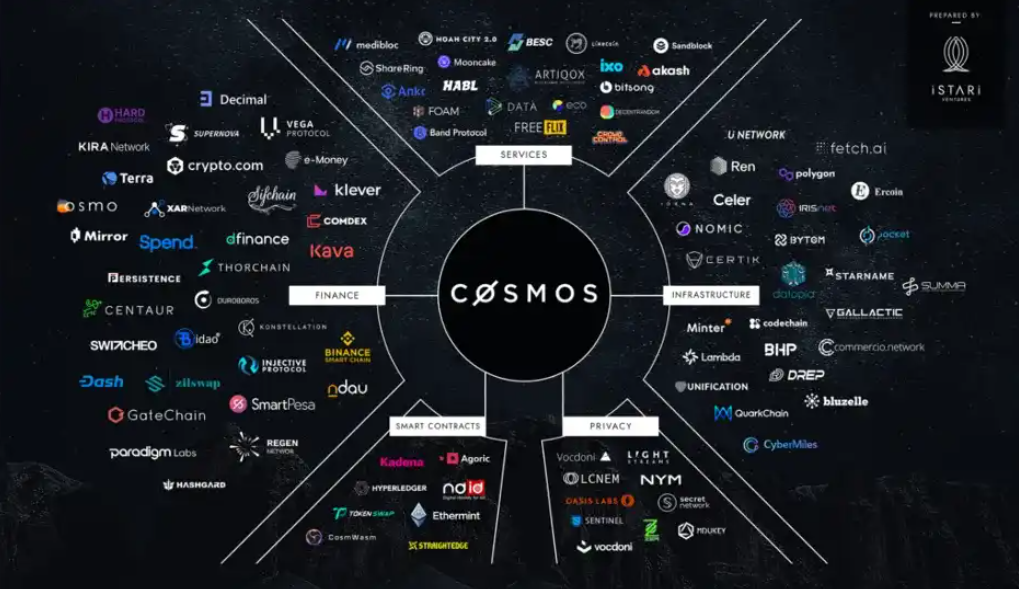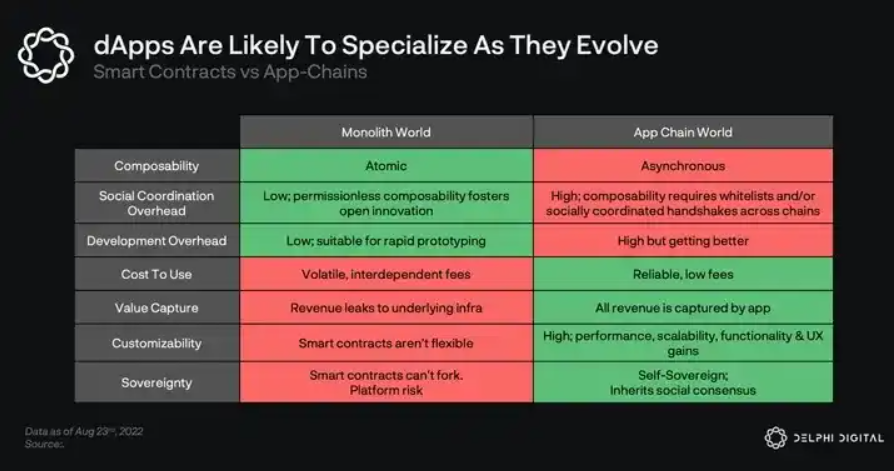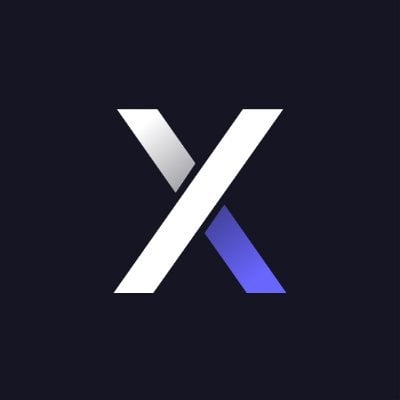Cosmos in the Eyes of Pantera Capital: Core Advantages, Innovations, and Key Ecosystems
Original Author: Paul Veradittakit, Partner at Pantera Capital
Original Translation: Leo, BlockBeats
Recently, Paul Veradittakit, a partner at Pantera Capital, wrote an article on "The Current Core Technologies and Ecological Projects of Cosmos," interpreting the core technological advantages of Cosmos, the innovative mechanisms on application chains, and several important projects currently on Cosmos. The translation by BlockBeats is as follows:
Today, traditional blockchains face significant challenges in promoting widespread adoption and scalability. One of the issues is the lack of interoperability between different chains, leading to complex and inefficient communication and data transfer. Additionally, because the design focuses on security rather than scalability, scalability has remained a primary challenge, resulting in slower communication, increased network congestion, and rising costs.
By introducing an interconnected blockchain paradigm, Cosmos offers solutions to these challenges, utilizing the Inter-Blockchain Communication (IBC) protocol to achieve seamless communication and secure asset transfers between different chains. With a standardized framework for inter-chain interoperability, Cosmos facilitates efficient cross-chain interactions, expanding the possibilities and practicality of blockchain technology. Furthermore, Cosmos addresses scalability issues through its modular architecture and consensus algorithm. Developers can use the Cosmos SDK to create application-specific blockchains, referred to as "zones." These zones (independent blockchains, also known as regions) can adopt different consensus mechanisms, allowing for horizontal scaling and performance optimization. By supporting parallel processing across multiple zones, Cosmos significantly enhances the network's transaction capacity and scalability, while also leveraging the Comet consensus algorithm to provide fast block confirmation times, increased security, and resilience against malicious attacks. This type of consensus algorithm serves as a reliable foundation for interconnected blockchain networks, combining efficiency, finality, and robustness.
1. Core: Cosmos SDK, IBC, and Comet
The Cosmos SDK provides developers with the ability to create customized blockchains or zones that meet specific needs and objectives. Utilizing the interoperability features of Cosmos, these customized zones expand the boundaries of inter-chain interactions. The Comet consensus algorithm enhances this capability, ensuring that the Cosmos network operates securely and efficiently. Additionally, IBC supports seamless communication across different chains.

1. Highlights of Cosmos
Interoperability: The strength of Cosmos lies in its guarantee of interoperability, allowing independent blockchains within the Cosmos network to connect easily. This interoperability fosters breakthroughs in cross-chain applications and collaborations, driving innovation and enhancing the practicality of decentralization.
Scalability and Performance: Cosmos addresses scalability issues by authorizing the creation of independent blockchains or zones, which can customize their consensus mechanisms and scalability according to user needs. This approach supports horizontal scaling by accommodating increased transaction volumes through the addition of extra zones. As a result, the Cosmos ecosystem boasts excellent performance and scalability.
Personal Sovereignty: The Cosmos ecosystem provides an ideal platform for creating chains focused on personal sovereignty. By leveraging the infrastructure provided by Cosmos, such as the Cosmos SDK, IBC, and Comet BFT consensus algorithm, developers can flexibly customize any aspect of the tech stack to enhance performance, throughput, security, and other critical factors of the chain. For example, EVM chains like Evmos are built using existing tech stacks. Additionally, dedicated application layers can be developed to support specific virtual machines (VMs), enabling the creation of chains that run on different VMs, such as Move or SVM.
Developer-Friendly Environment: Cosmos offers a friendly environment for blockchain developers. The Cosmos SDK is a feature-rich platform for building dApps. By utilizing the SDK's modular framework, developers can create their unique blockchains outside of the SDK, simplifying the development process. This streamlined approach allows developers to create customized chains extending from the Cosmos SDK, thereby increasing the adoption and growth of the blockchain ecosystem.
2. Cosmos Application Chains
Application chains are an indispensable part of Cosmos's innovative ecosystem, representing specialized and application-specific blockchains that meet different use cases. Unlike traditional monolithic blockchains, the modular approach adopted through the Cosmos SDK allows developers to customize consensus, storage, and networking mechanisms according to the specific requirements of their dApps. This grants application chains a degree of autonomy, enabling developers to better control their applications and enhance their ability to shape user experiences. Furthermore, the Cosmos application chain model offers enticing revenue opportunities, allowing dApp creators to explore unique monetization strategies and promote sustainable growth within their respective chains.
Additionally, the flexibility of Cosmos application chains extends to the handling of MEV (Miner Extractable Value). By providing developers with tools to design MEV strategies suited to their needs, Cosmos incentivizes fair and transparent MEV extraction, fostering a more equitable and efficient ecosystem. Moreover, the interconnectivity facilitated by the IBC protocol is a key advantage of the Cosmos application chain model. It supports seamless communication and asset transfers between different application chains, enabling the development of advanced cross-chain DeFi applications and expanding possibilities for developers and users alike. In summary, application chains within the Cosmos ecosystem provide a promising avenue for dApp development, offering sovereignty, revenue opportunities, flexibility in MEV, and seamless interoperability, thus nurturing a vibrant and thriving blockchain ecosystem.

1. Inter-Chain Security
Inter-chain security is a groundbreaking approach aimed at enhancing the security of new Cosmos chains and facilitating their smooth launch, involving the concept of "renting" economic security from established secure chains within the Cosmos ecosystem (Cosmos Hub).
2. Key Advantages
Economic Security Leasing: To launch new Cosmos chains, developers can leverage the security of the Cosmos Hub or other secure chains by locking a certain amount of the new chain's native tokens as collateral, helping to establish financial connections between the new chain and the secure chain.
Cross-Chain Security: By obtaining economic security through inter-chain security, new Cosmos chains are more resilient to attacks, relying on a diverse set of validators from the secure chain to protect their transactions and assets, thereby reducing the risk of 51% attacks and other security threats.
Independent Blockchains: Each Cosmos chain operates independently, with its governance, tokens, and use cases. However, through inter-chain communication protocols like IBC, they can securely exchange data and value, facilitating interoperability and synergy within the Cosmos ecosystem.
By adopting inter-chain security and collaborating within the Cosmos ecosystem, new chains can significantly lower entry barriers and gain access to robust and proven security infrastructure. This promotes innovation, accelerates the pace of blockchain development, and ushers in a new era of secure and interconnected dApps.
3. Cosmos SDK
The Cosmos SDK supports modularity, creating an ecosystem with a multitude of interchangeable modules. This approach liberates developers from the previous task of "building complex features from scratch." Instead, developers can seamlessly integrate pre-built modules into their applications, simplifying the creation of application-specific blockchains. The Cosmos SDK offers high flexibility in module customization, allowing developers to tailor these modules precisely to their application needs, opening up a realm for fine-tuning chain applications. As the Cosmos Network evolves, the ecosystem of SDK modules will also develop, providing developers with scalable options and functionalities. In this dynamic environment, complex and highly specialized blockchain applications can be nurtured, fostering innovation and driving the growth of the Cosmos ecosystem.
The Cosmos SDK also prioritizes security through its capability-based security concept. These features act as "guardians," clearly defining boundaries between modules and mitigating risks from malicious or unforeseen interactions. By protecting creation, the Cosmos SDK focuses on security measures.
4. Inter-Blockchain Communication Protocol IBC
IBC is a protocol within the Cosmos ecosystem designed to facilitate secure and decentralized communication across blockchains. It acts as a bridge, enabling data transmission throughout the Cosmos network. By utilizing cryptographic proofs and consensus algorithms, IBC ensures the integrity and credibility of inter-chain transactions, maintaining data confidentiality and preventing tampering or unauthorized access. This protocol not only enhances chain interoperability but also promotes collaboration and innovation by allowing project-based systems to leverage the network. With IBC, Cosmos has the potential to usher in a new era of interconnected blockchains, providing new possibilities for dApps, cross-chain asset transfers, and the creation of interconnected blockchain networks.
Tracking: Chain B continuously receives data headers from chain A, and vice versa. This allows each chain to track the validator set of the other chain, essentially running a light client of another chain.
Binding: When IBC transmission is initiated, tokens are bound.
Proof Relay: Then, 10 token binding proofs are relayed from chain A to chain B.
Verification: On chain B, the proof is verified against the data header of chain A, and if the proof is valid, 10 proofs are created on chain B.
3. Cosmos Environment
Currently, the Cosmos ecosystem is thriving, attracting a diverse array of projects and establishing influential partnerships. By leveraging the powerful infrastructure of Cosmos, these projects enter a highly interoperable blockchain space, potentially unleashing powerful network effects. This seamless collaboration and integration greatly enhance the overall ecosystem, fostering innovation and driving the adoption of Cosmos as a popular blockchain solution.
4. Cosmos-Based Projects
Osmosis is an innovative crypto project built on the Cosmos ecosystem, providing a DEX platform that facilitates liquidity provision. With the support of the IBC protocol, Osmosis enables seamless token swaps between different chains within the Cosmos network. This unique feature allows users to access a variety of assets and pools, promoting an efficient and secure trading experience. By leveraging Cosmos's interoperability and scalability, Osmosis creates an inclusive and interconnected ecosystem, enhancing liquidity and enabling cross-chain collaboration. With its focus on user-centric design and optimized liquidity management, Osmosis opens up new opportunities for DeFi participants, allowing them to explore a broader range of assets and maximize their trading potential.
dYdX is a DEX platform that has gained popularity for its user-centric approach to crypto trading, eliminating reliance on centralized entities while allowing users to have complete control over their private keys and assets, thus promoting a safer and more transparent trading experience. Operating on the Cosmos chain, dYdX utilizes the Cosmos SDK to facilitate fast and efficient trading, as well as seamless interoperability with other Cosmos-based applications. In addition to basic crypto trading, dYdX offers margin trading and lending services, catering to traders seeking leverage and lending users looking to earn interest on idle assets. With its strong security features, Cosmos presents a promising future for dYdX, fundamentally changing the way traders engage with cryptocurrencies while fostering the growth of the DeFi ecosystem.
Akash Network provides a decentralized cloud computing marketplace. By leveraging the security of Cosmos, Akash Network offers a secure platform where users can send data to each other and develop applications. The network operates on a PoS consensus mechanism, enhancing transaction security. The native token of Akash Network is AKT, serving as the utility token of the ecosystem. Through its integration with Cosmos, Akash Network benefits from the interoperability and scalability of a larger network, enabling seamless communication with other blockchain platforms. As a result, Akash Network empowers developers and organizations to access affordable decentralized cloud computing resources.
Sei Network is a high-performance blockchain platform that operates as L1 on the Cosmos SDK blockchain platform, providing financial services and facilitating the deployment of the DeFi ecosystem. The network was founded with the realization of the need for a decentralized financial system that prioritizes transaction speed and security while providing innovative financial tools for users. Sei utilizes its proprietary PoS consensus algorithm to provide secure transaction confirmations through tokenization and ownership verification. The platform's three-layer architecture includes a client layer, service layer, and chain platform layer, supporting high throughput with the capability to process up to 20,000 transactions per second. With built-in support for smart contracts in Rust and Solidity programming languages, developers can easily build customized projects and DeFi applications on Sei. The network's native token SEI serves as an internal asset for rewards, staking, and project governance, promoting a sustainable and prosperous ecosystem. Furthermore, Sei's integration with Cosmos grants it interoperability and scalability, allowing for seamless communication with other blockchain platforms and supporting broader adoption and easier access to decentralized financial services. Ultimately, Sei Network aims to become an affordable and powerful blockchain platform that drives financial inclusivity and supports the development of cutting-edge applications across the blockchain space.
Neutron is a DeFi platform within the Cosmos ecosystem that introduces a shift in cross-chain communication. Neutron positions itself as the first consumer chain on Cosmos, operating with open policies and the capability for inter-chain communication, facilitating seamless interactions between different blockchain networks. With CosmWasm supporting smart contracts in multiple programming languages, it offers flexibility and scalability. Its interoperability allows developers to access feature sets from other blockchains, opening up a new realm of possibilities and unlocking the true potential of blockchain technology. By adopting security from the Cosmos Hub, Neutron promotes a secure and reliable infrastructure, laying the groundwork for mutually beneficial relationships within Economic Zones. The characteristics and strategic positioning of Neutron herald a transformative era for the Cosmos ecosystem, having a profound impact on the future of DeFi and inter-chain collaboration.
Celestia is a project within the Cosmos ecosystem that provides consensus and security on demand. It aims to advance blockchain deployment by eliminating the need to bootstrap new consensus networks, significantly reducing overhead. Unlike traditional blockchains, Celestia's throughput scales with the number of users due to its unique data availability sampling properties. What sets Celestia apart is that its blockchain does not rely on the honest majority assumption to guarantee state validity, ensuring the highest security standards. Additionally, Celestia's flexible design allows developers to define their execution environments, granting them freedom and creativity. Celestia supports various types of Rollups, including EVM and Cosmos SDK, providing solutions for building interconnected blockchain networks with security and scalability.
Stride is a liquid staking platform built on the Cosmos blockchain that revolutionizes token staking and DeFi. By allowing users to stake any IBC-compatible token and receive stTokens as rewards, Stride unlocks liquidity and enables users to increase their yields through DeFi trading. This innovative approach allows users to maintain flexibility while earning rewards, fostering a more vibrant and productive ecosystem. The platform's emphasis on security has undergone multiple audits to ensure the safety of user assets. Stride's significance lies in its reshaping of the staking landscape, bringing enhanced liquidity and yield opportunities to the Cosmos ecosystem, and driving the growth of a broader DeFi space through seamless integration and user-centric governance.
Leap Wallet has launched an innovative mobile browser extension and application aimed at optimizing Web3 interactions on a simplified and secure basis. Leap emphasizes user sovereignty, ensuring that all assets remain under user control, adhering to decentralized principles. Fast and cost-effective asset swaps facilitate DeFi investments and NFT explorations. Leap's extensive network of collaborations with dApps, Aggregators, DEXs, and Marketplaces creates a premium Web3 experience. The platform has undergone rigorous audits to create a secure environment for users, fostering trust and confidence. Leap Wallet offers multi-platform support across various devices, including mobile phones, tablets, laptops, and desktops, serving as a multifunctional tool that enables individuals to explore the limitless potential of Web3 while safeguarding their financial future.
5. Conclusion
Cosmos's flexible architecture supports secure asset transfers between different chains and unlocks the full potential of blockchain technology. Notably, the thriving development of key projects like Terra, Polygon, and Cronos on early versions of Cosmos highlights its versatility in supporting diverse ecosystems. With the collaboration between the Noble chain and Circle, seamlessly introducing USDC into the Cosmos ecosystem, a new chapter in DeFi is opened, and users are increasingly optimistic about Cosmos. Tether's launch of its USDT stablecoin on Kava, an L1 chain built on Cosmos, further strengthens Cosmos's multi-chain presence and brings a vibrant and interconnected future to the entire crypto community.



















